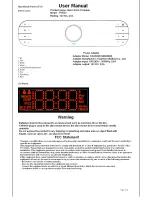
16
iW Series
Quick Start Guide
17
Installation Guide
Wall Clamp Mechanism
A unique clamping mechanism has been designed to provide an acoustically-optimum bond
to the wall surface without risk of distortion to the loudspeaker baffle.
The iW 4DC has four mounting clamps and screws, the iW 6DS has six, and the iW 62DS and
iW 62S have eight. As these screws are tightened, the immensely strong polycarbonate
clamping arms will automatically swing round into the locking position, locating securely to
the inside of the wall surface.
The design also allows for simple removal or reorientation of the loudspeaker.
The spring-loaded clamp mechanism ensures that as the screws loosened (turned anti-
clockwise) the clamp arm travels along its guide before turning itself into the rest position.
The captive locking system ensures that the clamp arm cannot drop off the end of the screw
to be lost in the wall cavity.
IMPORTANT
Get all the clamps in the rest position by loosening all screws before attempting to remove
the speaker from the wall.
Installation
WARNING:
If adding new speakers to an existing installation, or simply replacing old ones,
you must ensure that the amplifier driving the system is switched OFF.
WARNING:
Prior to proceeding with the installation, ensure that you accurately determine
the position of electrical cabling, pipe work and wall studs. Having selected a wall location
clear of any obstruction, measure carefully to ensure the correct placement.
Painting
Before proceeding with the installation, the grille and baffle panel can be painted to blend
with the surrounding decor.
When painting the baffle, be sure to carefully mask off the driver assemblies. It is important
to ensure that paint does not come into contact with the cone, roll surround or HF unit. It is
strongly recommended that the metal perforated grille is sprayed as this will avoid clogging
of the holes. If painting with a brush is the only option, then several thin coats of paint will
provide a superior finish to that achieved by one applied too thickly.
The speaker is supplied with a sheet of acoustically transparent protective foam fixed to the inside of the grille. Having painted the grille to match the room decor
please remove the original foam and replace with the spare sheet supplied in the accessory pack. It is important that this replacement foam is bonded to the grille over
it's entire area, using a suitable spray adhesive. Failure to do so will result in audible resonace.
Overview
Tannoy In-wall loudspeakers have been designed for installation into standard stud partition wall systems constructed with 102 by 51 mm (4" by 2") timber at 406
mm (16") centres. However, it is envisaged that they will generally be used in cavity wall installations constructed with standard thickness plasterboard. These are
guidelines and therefore do not preclude use of the Tannoy In-wall products in different locations and a wide range of other wall construction types, as long as they
have a secure clamping surface up to maximum thickness of 25.4 mm (1").
Driver cone movement at low frequencies may become excessive unless steps are taken in the wall cavity void behind the loudspeaker to provide a well sealed and
accurately controlled rear 'enclosure' volume. This will effectively act as an enclosure behind the speaker (see Speaker Loading Volume section in this manual).
Failure to ensure this, will affect the bass and midrange performance unfavourably.
Fig. 5 Clamps in the pre-install position (rest)
Fig. 6 Clamps in the install position
Connecting the iW 62S
1. The iW 62S may be operated in either passive or active mode.
2. In passive mode, the internal low pass filters provide the transition to the main speakers.
3. In active mode the internal low pass filters are bypassed, to allow the use of an external controller and power amplifier. This mode of operation is preferred for
optimum performance, as it allows low frequency extension and equalization to be applied, and the low pass crossover to be optimally configured to the main speaker
setup and room characteristics.
4. Passive or active operation can be set by the front baffle switch, behind the grille.
5. Run cabling from one pair of speaker terminals, back to the amplifier, ensuring the correct polarity. The other set of terminals are a link that can be run to
another speaker.
Summary of Contents for iW Series
Page 15: ......

































